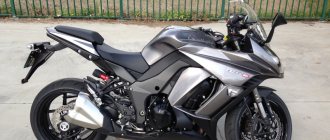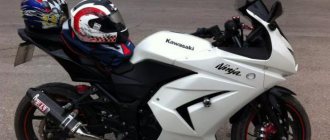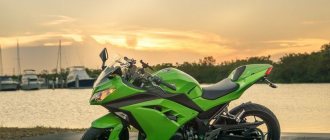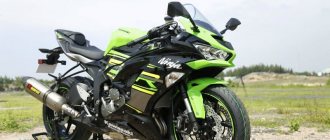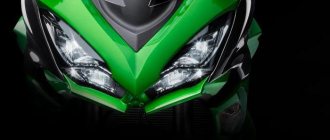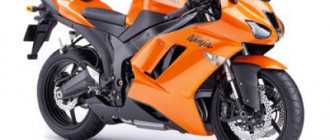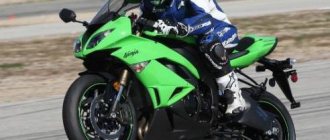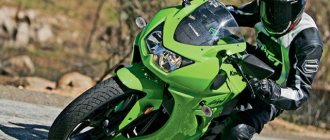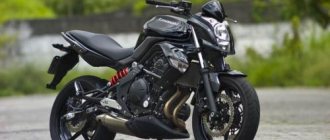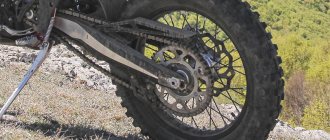Old or new? Kawasaki ZXR-400 or Ninja 400? Inexpensive rockets
Kawasaki ZXR-400
The Kawasaki ZXR-400 debuted 30 years ago and became a hit in the Japanese market. In Russia, it was loved for its maneuverability and great power. Today Ninja 400 is back. How much has he changed?
The ZXR 400, which debuted in 1989, was a unique motorcycle in its day. On the roads (of the world, but not of Russia), motorbikes of the 750 (GSX-R or ZXR 750) and 1000 (FZR) classes ruled the roost. The time of the six hundredths was still ahead. In the late 1980s, similar models appeared on the market - 250-400 racing models (for example, VFR 400 R), for which the Japanese participated in national championships. Due to their relatively high prices, these motorcycles were mainly popular in Europe.
However, over the years, many used motorcycles have been shipped to Europe. Today they are a delight for sporty driving enthusiasts because the ZXR 400 is cheap, tough to handle, and yet has a sporty character that, despite the passing of years, still succeeds.
In 2003, production of a sports four-cylinder “rocket” with a 400 cm3 engine was completed. Years later, Kawasaki returned to the idea of small-volume sports. First it was “250”, then “300”, and this year “400” debuted. What is the difference between the latter and its ancestor?
The most important difference is that the assumption behind the two machines is different. The ZXR 400 was designed to be a race car - fully equipped, fast, but also expensive. The Ninja 400 is a relatively inexpensive motorcycle and not very complex, but with significant sporting potential, so the amateur will have a great time, and the professional will get more than he expects.
The Ninja 400 is a slightly simplified motorcycle. It's reminiscent of the top-of-the-line ZX-10R, but has a tubular steel frame, traditional forks and single-disc brakes. The engine is in-line two-cylinder.
The ZXR 400's sporting ambitions are evident in every detail. Its front pivot is an inverted fork, and the brakes are two discs at the front and one at the rear with four-piston calipers. Frame: dorsal, made of aluminum. The engine is, finally, a four-stroke with a short stroke. In total, this is a miniature of the ZXR 750, which was then the pinnacle of sports motorcycles. The engine likes to rev high (up to 14,500 rpm) and already offered plenty of power in the production version. Performance from 65 to 68 hp. with a volume of 400 cubic meters. cm is impressive even today - from 162.5 to 172 hp! In the early 90s it was a sensation. Even good bikes could then squeeze out no more than 80 hp.
Kawasaki ZXR-400
The engine of the new Ninja 400 is designed differently. Liquid-cooled twin-cylinder heart producing 48 hp. Enough to make the ride enjoyable, it is also easy to handle for a motorcyclist with an A2 license. Its strong points are linear power, versatility, durability and low price.
Just as the technology of the models differs, so does the behavior of the engines. The two-cylinder engine is fast and quiet. The four-cylinder engine is more demanding and expressive. The 4-cylinder requires a long rotation of the starter, but, as I said, it sounds like music. On the Ninji 400, you can engage the clutch with one finger, stick the unit into the slightly working box and drive away. The ZXR 400 has a stiff clutch lever, and the unit's clatter is accompanied by a pronounced touch. To drive, you need to crank the engine to at least medium speed. Dynamic riding on the ZXR 400 doesn't come easy. You need to learn to ride this motorcycle.
The Ninja 400 doesn't have as much power as the ZXR 400, but has a strong midrange and a significantly downsized Chinese engine than the ZXR 400. It weighs 16kg less than the ZXR, has narrower tires and offers a more upright position at the helm. Softly shock-absorbing suspensions provide comfort and good control over the situation. After turns, the Ninja is lively, active but free, and rarely requires the engine to rev quickly or brake hard before the next turn.
And the ZXR 400 forces you to do this. Between 6,000 and 10,000 rpm - the mid-range in this car - there is good flexibility, but the wings only develop higher. The engine instantly revs to 14,000 rpm and after a short run on the highway reaches almost 220 km/h. It's too fast for the Ninja 400.
Kawasaki ZXR-400
The ZXR 400 is more demanding in corners, but also has more capability. It was felt that where the suppression of the Ninja reached its limits, it was just beginning. It becomes clear why the suspensions are rigidly tuned and have such dimensions. The accuracy of guidance and forward feedback are still pleasing today, but the reserve... is still great!
The ZXR has a poor driving position: the sofa is too low, the footrests are too high (this requires high ground clearance when folded), i.e. the bike is aggressive... but also uncomfortable. However, this is a low price to pay for a piece of Kawasaki racing history that, despite 30 years, is still impressive. If after this text you don’t think for even a minute that it would be nice to have a ZXR-400 in the garage, then something is wrong with you!
Post Views: 3,890
Similar articles:
No similar
Kawasaki Ninja 400 at EICMA-2017: Is the new “four hundred” the best choice again?
Kawasaki exploded the motorcycle market in Russia in 2008 by launching the brand new Ninja 250 sportbike. Could this moment really return in 2021, but with a “four hundred”?
MOTOGONKI.RU, November 9, 2021 —
Milan Motor Show EICMA-2017: Kawasaki Ninja 400 go to photo gallery
At EICMA 2017, the plant showed a completely new Kawasaki Ninja 400 bike, built on a similar concept to the Ninja 300, but a little more powerful and faster.
Milan Motor Show EICMA-2017: Kawasaki Ninja 400 go to photo gallery
400cc motorcycles are a natural thing in Japan, the UK and Australia. In Europe, either 250 cc models or “six hundred” models predominate. But the new Ninja is a full-fledged “four hundred”, and it is for Europe!
Milan Motor Show EICMA-2017: Kawasaki Ninja 400 engine go to photo gallery
Here is a 2-cylinder in-line engine with a volume of 399 cc. 45 hp, 10 l.m. more than that of the Ninja 300. A completely rebuilt air intake and intake channel - it passes not through the top, but from the bottom, thanks to which it was possible to significantly improve the smoothness of the engine and output, although the power is not so prohibitive. It is worth remembering that almost any previous “four hundred” from the 90s with a 4-cylinder engine produced 53 hp or more.
Milan Motor Show EICMA-2017: pictures from the exhibition go to photo gallery
But the new Ninja 400 is much more practical and technologically advanced. Here in the base there is a slipper clutch with a diameter of 125 mm with 20% less spring stiffness, but with better friction control. A new, much more efficient radiator, a lightweight steel birdcage frame like the H2, and the engine are also part of the supporting structure. Thanks to this, it was possible to reduce the curb weight to 168 kg. But here, the new Ninja 400 will give odds to all the “four hundred” from the past, weighing from 175 to 220 kg!
Milan Motor Show EICMA-2017: Kawasaki Ninja 400 chassis go to photo gallery
The chassis, however, is extremely simple and without frills: a classic fork at the front, a monoshock absorber, a steel frame in which the engine is suspended. The front brake is a 310 mm single disc with a 2-piston caliper.
Milan Motor Show EICMA-2017: Kawasaki Ninja 400 dashboard go to photo gallery
In terms of style, the new bike fits completely into the “as one” concept - similar to the Ninja ZX-10R, even if it has something similar to the H2 and other Kawasaki sportbikes. The bike features the same digital instrument panel as the Ninja 650, with full LED headlights, brake lights and turn signals.
Milan Motor Show EICMA-2017: Kawasaki Ninja 400 go to photo gallery
Technical characteristics of Kawasaki Ninja 400
Engine: liquid cooled, 4-stroke, 2-cylinder. in-line Volume: 399 cc. Diam. x stroke: 70.0 x 51.8 mm Compression ratio: 11.5:1 Max. power: 45 hp at 10,000 rpm Torque: 38 Nm at 8,000 rpm Power system: 2 injectors with a 32 mm diffuser Ignition: digital Start: electrical Clutch: oil bath, mechanical, slipping Transmission: 6 -step Rear wheel drive: chain Frame: steel, birdcage Front suspension: classic fork, 41 mm, travel - 120 mm Rear suspension: gas-filled monoshock on a Uni-Trak lever, travel - 130 mm, adjustable spring preload Front wheel: 110 /70R17 M/C 54H Rear wheel: 150/60R17 M/C 66H Brakes: front - one 310 mm semi-floating disc, 2-piston caliper Rear - one 220 mm disc, 2-piston caliper Dimensions (L x W x H): 1990 x 710 x 1120 mm Wheelbase: 1370 mm Ground clearance: 140 mm Seat height: 785 mm Curb weight: 168 kg Fuel tank: 14 l
I was looking for a four hundred, but I didn’t want to take some kind of antiquity from the shaggy years, so the cb400, bandit 400 and other popular motorcycles were no longer options. In one motorcycle dealership I came across a Kawasaki ER-4 purely by chance and was surprised - I didn’t even know about such a motorcycle. At first I didn’t even think that it was a 400cc, it seemed too big compared to other 400cc. Then they explained that it was built on the same components as Ruff, and differs from it only in cylinders and some other small things. My ER4 turned out to be 2012, it cost reasonable money, so I decided to take it.
I can say that for 400 cc it drives briskly, it picks up an honest 180 mph on the speedometer, albeit reluctantly, but it accelerates to 130-140 very quickly. Having heard a lot about the lack of low end on in-line 400s, I was preparing for the worst, but was delighted - there is low end! Maybe not like a chopper, but it’s there, and it’s better than on an inline four or four hundred. It drives best at medium speeds, because there’s really no top end - if you turn it all the way, the engine starts to squeal, and it seems like it’s not feeling well.
Even out of habit, the gearbox was alarming, it’s somehow painfully noisy when shifting, and there are some jerks, but neutral is found without problems, and I didn’t find any bugs, apparently, it’s just a feature of the gearbox. But six gears are good, without them one could say that the motorcycle doesn’t move, but with them it’s completely fine. But the consumption is good; in the city it’s about five liters, outside the city it’s about four. Eats 92nd. The gas tank lasts a long time; it holds 15 liters.
Now for the downsides, there are plenty of them too. Firstly, there is practically no protection from the wind; the wind is felt already after 110-120 kmh, and at 150 it blows away completely. You could probably put the glass higher, but the standard one can’t cope with the wind. Another weight is more than two hundred kg, more than many other four hundred. When you move the motorcycle in place, you feel all its kilograms. And it seems comfortable to sit, but it’s a bit cramped for the legs, and the main problem is that there is a very small gap between the left driver’s footrest and the gearbox foot, the foot simply doesn’t want to fit in there properly. Well, these are all minor things, probably, the motorcycle is generally good enough for its price. An ordinary four hundred, only fresh and with lows.
Similar articles:
- Yamaha XJR 1200 owner review
- Kawasaki Ninja 250 R owner review
- Kawasaki ZL 400 Eliminator owner review
- Honda X4 owner review
- Kawasaki EN 400 owner review
- Yamaha XJR 400 owner review
LiveJournal
